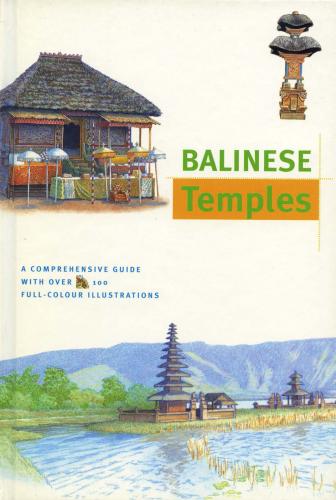The padmasana is in effect a representation of the cosmos in miniature. The base is divided vertically into three stepped platforms corresponding to the three principle divisions of the cosmos-buhr (the netherworld of the demons), buwah (the realm of man) and swah (the domain of the gods). A stone throne sits on top with a high back which often is ornamented with a carving of a swan or alternatively an eagle, the swan being the identified as the mount, or vehicle, of Brahma, and the eagle, that of Vishnu.
Balinese temples are not conceived as places where the gods are permanently in residence, but rather as temporary sanctuaries where the gods alight when they descend from the heavens to attend a temple ceremony.
Unlike Hindu temples in India and in ancient Java, there are no physical representations of the deities housed in the various pavilions and shrines that provide a sanctuary for the gods during Balinese temple festivals. The gods are, however, invited to inhabit small wooden effigies called pratima. The latter come in pairs, the larger, more animal-like, of the two representing the mount upon which the deity rides.
The most important ritual structures are situated in the inner sanctum, or jeroan, but there are places for offerings located at other strategic points in the temple complex—for example, on either side of the principal gateways which lead from one courtyard to another. Gateways themselves play an important part in the symbolic order of Balinese temple architecture, creating thresholds between the secular world outside and the realm of the sacred within.
Padmasana
There are two principal types of shrine—the padmasana, or 'lotus seat', and the meru, a wooden house-like structure with a masonry base and a multi-tiered roof. The padmasana is a small stone seat, raised some one and a half metres off the ground, and is intended as a resting place for the gods when they attend a temple festival.
There are three basic types which are classified according to the number of seats provided. The single-seater version is identified as the throne of Siwa, or alternatively, the sun-god Surya. Then there is a double-seated version which is dedicated to the deified ancestors—one male and one female. Finally there is a triple-seated version which may also be dedicated to the ancestors, or alternatively to the Hindu trinity (trimurti) of Brahma, Siwa and Vishnu. The most important padmasana is placed in the most sacred (kaja-kangin) corner of the inner courtyard with its back to Gunung Agung. This shrine is dedicated to the Supreme Deity, Ida Sanghaya Widhi Wasa in his manifestation as Siwa Raditya, the Balinese counterpart of the ancient Hindu sun-god, Surya.
Конец ознакомительного фрагмента.
Текст предоставлен ООО «ЛитРес».
Прочитайте эту книгу целиком, купив полную легальную версию на ЛитРес.
Безопасно оплатить книгу можно банковской картой Visa, MasterCard, Maestro, со счета мобильного телефона, с платежного терминала, в салоне МТС или Связной, через PayPal, WebMoney, Яндекс.Деньги, QIWI Кошелек, бонусными картами или другим удобным Вам способом.
